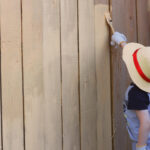Installing a fence on your property can enhance privacy, security, and aesthetics. However, determining where exactly to place the fence can be a source of confusion for many homeowners. Can you put a fence right on your property line, or are there rules and considerations to keep in mind? In this blog, we will explore the guidelines and factors involved in placing a fence on your property line.
Understanding Property Boundaries
Before delving into fence placement, it’s essential to understand your property boundaries. Property boundaries are the lines that legally define the limits of your land. These boundaries are typically established through surveys or legal descriptions and are crucial for determining where you can place a fence.
Consulting a Professional Surveyor
To accurately identify your property boundaries, it’s advisable to consult a professional surveyor. A surveyor can assess your property and provide you with a precise boundary survey, which will outline the exact location of your property lines. This information is vital when considering fence placement, as it helps ensure that the fence is entirely within your property.
Local Zoning Regulations and Building Codes
Once you have a clear understanding of your property boundaries, it’s important to review local zoning regulations and building codes. Different municipalities have specific rules and guidelines regarding fence placement. These regulations may dictate fence height restrictions, setback requirements (distance from property lines or public right-of-ways), and material restrictions. Familiarize yourself with these regulations to ensure compliance and avoid potential penalties or disputes with neighbors.
Shared Fence Ownership
In some cases, property lines may be shared with neighboring properties. This situation raises the concept of shared fence ownership. Shared fence ownership means that both you and your neighbor are responsible for the construction, maintenance, and repair of a fence along the property line. It’s crucial to communicate with your neighbor and reach an agreement on fence-related responsibilities to avoid disputes.
Boundary Agreements and Easements
In certain situations, property owners may opt to establish a boundary agreement or easement with their neighbors. These agreements specify the rights and responsibilities of each party regarding fence placement, maintenance, and usage. If you are considering installing a fence on your property line, discussing the matter with your neighbor and formalizing an agreement can provide clarity and prevent future conflicts.
Professional Installation and Communication
When installing a fence on your property line, it’s essential to hire a professional fencing company. A professional installer will have the expertise to ensure that the fence is properly placed within your property boundaries, adhering to local regulations and building codes. Additionally, maintaining open lines of communication with your neighbors throughout the installation process can help address any concerns or issues that may arise.
Placing a fence on your property line requires a clear understanding of your property boundaries, local regulations, and communication with neighbors. By consulting a professional surveyor, familiarizing yourself with zoning regulations and building codes, considering shared fence ownership or boundary agreements, and hiring a professional installer, you can confidently install a fence that meets your needs while adhering to legal requirements. Remember, open communication and mutual respect with your neighbors are key to maintaining positive relationships and resolving any potential conflicts related to fence placement.







